Welcome to another delightful culinary journey! Today, we're diving into the world of Asian cuisine with a mouthwatering and delicious Shrimp Lo Mein recipe. This dish is not only bursting with flavor but is also incredibly easy to whip up. So forget Chinese takeout. You can make this great one-pot weeknight meal at home. It only takes 30 minutes to make, and it's family-friendly, too!
Don't forget to try my Chicken Lo Mein recipe too! And if you want to know the difference between Lo Mein vs. Udon Noodles, check out my blog post! Don't know how to cook dried udon noodles? I've got you covered!
Jump to:
Ingredients
- Lo Mein Noodles: Use either dried, frozen, or fresh noodles.
- Shrimp: Use already cleaned, shelled, and deveined shrimp to save prep time.
- Vegetables: Use all or any combination of carrots, red bell pepper, sugar snap peas, snow peas, and/or broccoli.
- Garlic: I always use fresh garlic. It has more flavor!
- Soy Sauce: Any variety will do. I used dark soy sauce for this recipe.
- Oyster Sauce: Packs a punch of flavor, so don't skip this one.
- Hoisin Sauce: Gives the dish a glazed, thick, caramel color with a slight barbecue and woodsy taste. Does that make sense? It's sweet, salty, and tangy. Trust me, it's good!
- Sesame Oil: Comes from sesame seeds. It has a nutty and earthy taste that complements all the other sauces in this recipe.
- Cooking Oil: I prefer to use olive oil.
- Ginger: The flavor profile of ginger is somewhat sweet with citrusy notes.
- Green Onions: Optional for garnish
Please refer to the recipe card for exact measurements for ingredients.
What's the Difference Between Sugar Snap Peas and Snow Peas
These two ingredients are different yet can be used interchangeably in many recipes.
Sugar snap peas are a cross between snow and garden peas. You'll see the difference in structure. Snow peas have pods that are flatter than small, premature peas. Sugar snap peas, on the other hand, are more rounded.
They are similar because they have an identical nutritional profile and very similar flavors. Sugar snap peas tend to be sweeter and more flavorful.
Substitutions
If you need to make substitutions in the ingredients for Shrimp Lo Mein, here are some alternatives you can consider based on dietary preferences or ingredient availability:
Noodles
- Any noodles will work great for this recipe. If you prefer a gluten-free option, substitute lo mein noodles with egg noodles, udon noodles, or even rice noodles.
Shrimp:
- Replace shrimp with chicken or beef. And for a vegetarian version, use tofu or a mix of your favorite vegetables.
Mixed Vegetables:
- Feel free to customize the vegetable mix based on what you have or prefer. Options for fresh veggies include baby bok choy, bean sprouts, bell peppers, broccoli, snap peas, carrots, mushrooms, napa cabbage, shiitake mushrooms, and baby corn.
Soy Sauce:
- Use reduced-sodium soy sauce or tamari if you want a low-sodium option. For a gluten-free alternative, opt for gluten-free soy sauce or tamari.
Oyster Sauce:
- Fish sauce can also be a good alternative to oyster sauce. It will have a more pungent flavor and less sweet than oyster sauce. Substitute oyster sauce with vegetarian oyster sauce or hoisin sauce if you want a vegetarian version.
Hoisin Sauce:
- If hoisin sauce is unavailable, you can make a quick substitute by combining soy sauce, peanut butter, honey, and a touch of garlic.
Sesame Oil:
- If you don't have sesame oil, try olive oil or another neutral cooking oil.
Vegetable Oil:
- Substitute vegetable oil with olive oil, peanut oil, or any other cooking oil you have on hand.
Garlic and Ginger:
- If you don't have fresh garlic or ginger, you can use garlic powder and ground ginger as alternatives.
Remember to adjust quantities based on personal taste preferences and dietary restrictions. Cooking is all about experimentation, so feel free to get creative with substitutions to make the dish your own!

Instructions
- Cook the Noodles: Boil the lo mein noodles according to the package instructions. Once cooked, drain and set aside.
- Prepare the Shrimp: In a large skillet or wok, heat one tablespoon of vegetable oil over medium-high heat. Add the shrimp and cook until pink and opaque. Remove the shrimp from the pan and set aside.
- Stir-fry Vegetables: In the same pan, add another tablespoon of vegetable oil. Stir-fry the minced garlic and grated ginger until fragrant. Add the mixed vegetables and cook until they are crisp-tender.
- Combine Sauce: In a small bowl, mix together soy sauce, oyster sauce, hoisin sauce, and sesame oil. Pour the savory lo mein sauce over the vegetables and stir to combine.
- Combine Shrimp and Noodles: Add the cooked shrimp and lo mein noodles to the pan. Toss everything together until well coated in the sauce and heated through.
- Garnish and Serve: Garnish with chopped green onions for a burst of freshness. Serve your Shrimp Lo Mein hot and enjoy the delectable flavors!
Storage and Reheating Leftovers
Properly storing leftovers is crucial to maintain freshness and ensure food safety. Here's a guide on how to store and reheat leftover Shrimp Lo Mein:
- Cooling: Allow the Shrimp Lo Mein to cool to room temperature before storing. This is a great way to help prevent the formation of condensation inside the container, which can lead to sogginess.
- Refrigeration: Transfer the leftover Shrimp Lo Mein to an airtight container. Ensure the container is suitable for refrigerator use. Seal the container tightly to prevent air from entering, which can cause the food to dry out.
- Labeling: Consider labeling the container with the date so that you can keep track of how long it has been in the refrigerator. Leftovers are generally safe to eat within 3-4 days when stored properly.
- Storage Location: Place the sealed container in the refrigerator. Store it on a shelf rather than in the refrigerator door, as the door experiences temperature fluctuations each time it's opened.
- Avoid Overcrowding: If you have a large amount of leftovers, divide them into smaller portions before refrigerating. This allows the food to cool more quickly and evenly.
- Reheating: When you're ready to enjoy the leftovers, reheat them thoroughly. Use a microwave, stovetop, or oven, ensuring the internal temperature reaches at least 165°F (74°C) to kill any potential bacteria.
- Quality Check: Before reheating, check the quality of the leftovers. If the Shrimp Lo Mein has an off smell, unusual color, or unusual texture, it's best to discard it to ensure food safety.
Conclusion
There you have it – a delightful Shrimp Lo Mein that's perfect for a quick weeknight dinner or a weekend feast. This recipe is a testament that creating restaurant-quality dishes at home can be both easy and rewarding. Give it a try, and let your taste buds dance with joy!
FAQ
Here's a set of frequently asked questions (FAQ) related to Shrimp Lo Mein, along with their answers:
Absolutely! Shrimp can be substituted with chicken, beef, tofu, or even a mix of your favorite fresh veggies for a vegetarian version. Adjust cooking times accordingly.
Yes, you can. Depending on your preference or dietary needs, fresh lo mein noodles can be substituted with fresh egg noodles, udon noodles, or rice noodles.
Certainly! Use gluten-free soy sauce or tamari, and choose gluten-free noodles to make the dish gluten-free.
While it's best enjoyed fresh, you can prepare components in advance. Cook the noodles and prepare the savory sauce ahead, but stir-fry the vegetables and shrimp just before serving to maintain their texture.
Absolutely! For a spicy kick, add red peppers or red pepper flakes, sriracha, or your favorite hot sauce to the sauce mixture.
Rinse the cooked noodles under cold water after boiling to remove excess starch. Toss them with a bit of oil to prevent sticking.
Other Recipes for Noodles
Looking for other noodle recipes like this? Try these:
Cooking Tips for Noodles
These are my favorite dishes to serve with [this recipe]:
📖 Recipe

Ingredients
- 8 ounce Lo Mein Noodles
- 1 pound Large Shrimp Peeled and Deveined
- 2 cups Mixed Vegetables Carrots, Bell Peppers, Sugar Snap Peas, Broccoli
- 3 cloves Garlic Minced
- 2 tablespoon Soy Sauce
- 1 tablespoon Oyster Sauce
- 1 tablespoon Hoisin Sauce
- 1 teaspoon Sesame Oil
- 2 tablespoon Vegetable Oil or Olive Oil
- 1 teaspoon Fresh Ginger Grated
- Green Onions Sliced for garnish (optional)
Instructions
- Boil the lo mein noodles according to the package instructions. Drain and set aside.8 ounce Lo Mein Noodles
- Heat one tablespoon of vegetable oil over medium-high heat in a large skillet or wok. Add the shrimp and cook until pink and opaque. Remove the shrimp from the pan and set aside.2 tablespoon Vegetable Oil, 1 pound Large Shrimp
- In the same pan, add another tablespoon of vegetable oil. Stir-fry the minced garlic and grated ginger until fragrant. Add the mixed vegetables and cook until they are crisp-tender.3 cloves Garlic, 1 teaspoon Fresh Ginger, 2 cups Mixed Vegetables
- Mix soy sauce, oyster sauce, hoisin sauce, and sesame oil in a small bowl. Pour the savory lo mein sauce over the vegetables and stir to combine.2 tablespoon Soy Sauce, 1 tablespoon Oyster Sauce, 1 tablespoon Hoisin Sauce, 1 teaspoon Sesame Oil
- Add the cooked shrimp and lo mein noodles to the pan. Toss everything together until well coated in the sauce and heated through.
- Garnish with chopped green onions for freshness. Serve your Shrimp Lo Mein hot and enjoy the delectable flavors!Green Onions
Notes
- Substitute shrimp with other proteins like beef, chicken, or pork.
- For a vegetarian option, use tofu.
- Other types of noodles can be used for this recipe.
- Serve with hot sauce or sriracha to make this dish spicy!





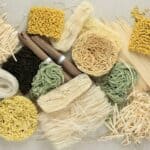

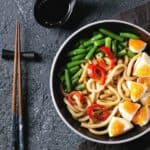






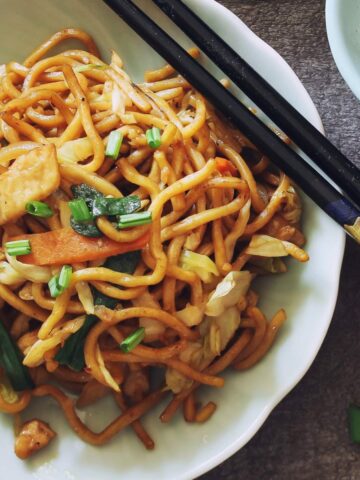

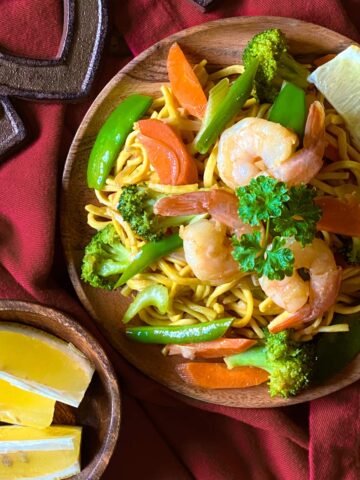
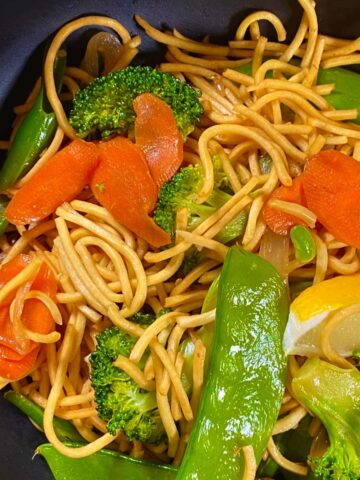









Comments
No Comments